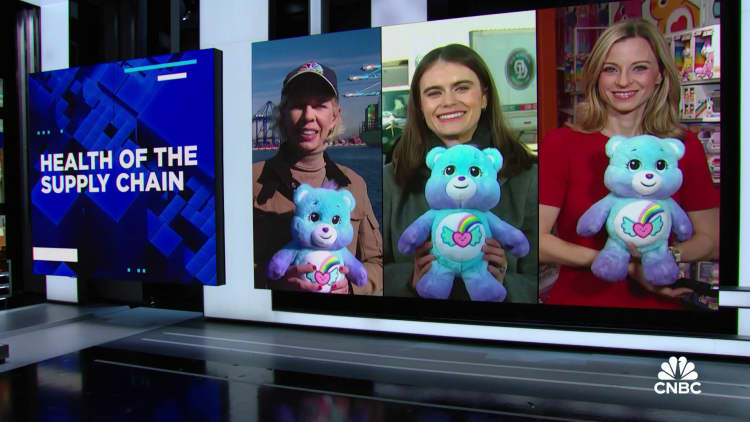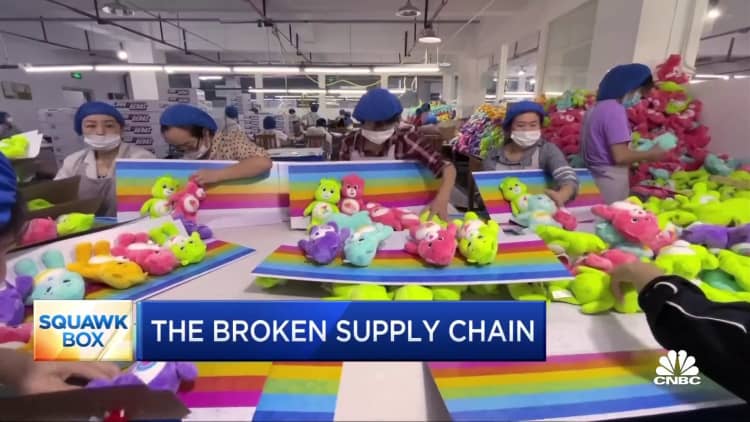Business is largely back to normal along the global supply chain, including where it all begins for the Care Bear: the factory floor in China.Anward S

Business is largely back to normal along the global supply chain, including where it all begins for the Care Bear: the factory floor in China.
Anward Shen, owner of An’Best Toys in China, which produces the plush toys for U.S. retailer Basic Fun!, said the cost of making a Care Bear is back to where it was before the pandemic. He said his factory in the northwestern city of Ankang produces a million Care Bears every month.
Covid exposed weaknesses throughout the system, and so it took much longer, cost considerably more and led to tighter inventory availability for some time. During the global supply chain disruptions in 2021, Shen told CNBC the cost to produce a Care Bear had soared by 25% that year.
“Compared to October of 2021, it’s really night and day” said Jay Foreman, CEO of Basic Fun! “Everything was out of balance, every step in the supply chain.”
Now, while it’s easier to get Care Bears to American shoppers, and at lower prices, there are new strains in the system, reflecting divergent economic realities in the U.S. and China.
For instance, unlike in the U.S., where policymakers tackle stubborn inflation amid a resilient economy, Beijing is battling deflation and slower growth.
Workers making Care Bears at a factory in Ankang, China.
CNBC
The slowdown has depressed material prices. High unemployment in the country has allowed manufacturers to rein in rising wages for workers. And with demand declining globally, factories are bidding for U.S. orders more aggressively by offering price cuts.
Shen said the move helps customers and allows him to retain their business. “We passed on nearly all of the cost savings to U.S. buyers and their customers,” he said. “They want the cheaper price. We need the orders.”
Logistics costs are also in check. Beijing’s decision to lift restrictive Covid controls at the end of 2022 has eased travel across the country. Shipping containers are plentiful at the Chinese ports. Shen said his American buyers are still working through old inventories, freeing up freight space.
“Many buyers overseas bought too much when it looked as though the market was recovering from the pandemic,” he said. “They are de-stocking now.”
In 2021, Care Bears were held up for up to two months, adding to costs. Now, they’re shipped out almost immediately while deflation ripples through export industries.
Funshine Bear
It’s 10 a.m. on a Wednesday, and out on the open water beyond the Port of Los Angeles are two ships carrying fuel, plus another with automobiles. Any large ships loaded with cargo from Asia are already inside the port, being processed by dockworkers.
What a difference two years makes.
During the supply chain mess of 2021 — when CNBC followed the journey of a Care Bear from a factory in China to a store in New York — there were 65 container ships anchored off the ports of L.A. and Long Beach. “Some vessels without reservations were sitting outside the port for weeks on end,” said Gene Seroka, the L.A. port’s executive director.
Those ships waited up to 10 days for an appointment to be unloaded. Even after that, containers sat on the docks another 11 to 13 days before being lifted onto a truck or train. The cost of a single traditional shipping container skyrocketed to around $20,000.

Many Christmas items did not arrive in time.
This year, ships sail right in. Seroka said unloaded cargo is only waiting three days to be placed onto trucks or trains — back to prepandemic turnaround times. Shipping container costs have fallen 90%, he added, back into “normal” territory.
But not everything is back to normal.
Half the truck gates at the port go unused every day, according to Seroka – “and that means we have capacity.”
Global trade is down 5% this year, according to the United Nations. Many U.S. retailers bought up inventory early — too much inventory, in many cases — as consumer demand softened.
But there’s another reason for the lack of activity at his port, Seroka said. The supply chain backlog of 2021 drove some business away from the West Coast. It didn’t help that the dockworkers’ union contract was expiring, and negotiations dragged on for months.
Shippers began looking at the Panama Canal, which underwent an expansion that ended in 2016. They redirected ships there, and cargo traffic began rising at east coast ports as it fell out west. Seroka said the ports of Los Angeles and Long Beach went from handling at least 40% of all containers to 33%.
“History has shown that when cargo moves away from the Southern California ports, some of it stays in those other port locations,” Seroka said. He’s now criss-crossing the country trying to win back business. “It’s been an uphill battle.”
Mother Nature may be helping him. A drought has lowered water levels at the Panama Canal, and some ships can no longer pass through. FreightWaves reports that 22% fewer ships transited the canal in November compared to October. The Panama Canal Authority says 2023 could be the second driest year on record.
As a result, container volumes are rising again along the West Coast. In November, total standard container numbers jumped 19% at the Port of Los Angeles versus a year ago, and increased 24% at the Port of Long Beach. In contrast, the numbers fell 6% in New York and New Jersey.
Bottom line, it’s become faster and cheaper again to ship to Southern California. That could be good news for retailers – not to mention Care Bears – assuming consumers stay in a buying mood.
Grumpy Bear
It’s a similar story on land. Costs for the next stage of a Care Bear’s journey – moving the toy from the port to a warehouse and on to a retailer – have come down. After consumers loading up on goods during the pandemic, consumers have shifted their spending to experiences. That means trucks and trains are transporting fewer things.
In October, contracted freight volumes dropped 6% year-over year, according to data the American Trucking Associations gave to CNBC, with spot volumes down nearly 40%. This eats into trucking companies’ profits since they’re paid based on how much cargo they transport. Lower volume translates to higher competition for each load, leading to a decline in trucking companies’ revenue per mile.
The drop in demand coincides with excess supply. During the pandemic when shipping rates soared, and retailers couldn’t get goods to consumers fast enough, a host of companies entered the market. But now there are too many trucks on the road, and executives are pointing to a “freight recession.”

“Trucking has been in a recession for a year,” said Bob Costello, chief economist at American Trucking Associations. There are too many trucks, and too little freight, he said. “It is not a good environment.”
Cost pressures also remain high for trucking companies, in part because of wage growth, which has outpaced other industries. This difficult operating environment has already pushed some companies into bankruptcy, such as Yellow.
Costello believes the pain isn’t over yet, saying that “not an insignificant number of people” will likely leave the industry next year.
While there’s no question the market has flipped from one favoring freight to one that favors the shipper – in most cases, that’s the manufacturer or the retailer – part of the reversal is also thanks to supply chain normalization.
Still, things might get worse for the trucking industry before getting better. The latest CNBC Supply Chain Survey shows that the global freight recession will continue in 2024, with low order expectations – at least for the first half of the year.
Christmas Wishes Bear
The Care Bear’s journey is faster and cheaper than two years ago, but whether these savings are passed along to the consumer is typically in the hands of the retailer.
Before they settle at home with their new owners, the Care Bears’ final destinations in the supply chain are either store shelves or distribution centers.
Foreman, the Basic Fun! CEO, said the cost of labor is higher right now than it was in October 2021, when CNBC first highlighted the Care Bear’s journey and cost. But there’s less pressure on manufacturing and transportation costs, “so things are kind of balancing out.”
The Care Bear journey took more than two months from the manufacturing facility in China to U.S. retail stores in October 2021. Now, Foreman says it’s back to normal, taking between 32 and 35 days.
Care Bears for sale at Toys R Us, American Dream Mall, East Rutherford, NJ.
Courtney Reagan | CNBC
Transportation made up nearly a quarter of the total cost of the Care Bear in the fall of 2021. It’s back down to 5% today.
Two years ago, Basic Fun! added a transportation surcharge to retailers’ invoices to cover added costs throughout the supply chain, which left retailers to decide whether to pass them along to consumers in the retail price.
Most retailers are charging about $15 for the 14-inch Care Bear, down from $17 to $20 in 2021, according to CNBC research. Foreman attributes this to a combination of lower supply chain costs, deflation, seasonal discounting and consumer preference for lower priced toys.
The Care Bear price drop is more than the overall toy price deflation. Toy prices are down nearly 3% in November this year from last year, and down more than 2% from two years ago, according to the latest consumer price index data.
“The average spend of our customer going down, last Black Friday the average spend was $36 per toy that was purchased from us, this year it’s $21.95 per toy,” which Foreman said is leading to more, but smaller less expensive, toys under the Christmas tree. “There’s lots of deals on toys this year.”
The supply chain has normalized, but “now the big challenge is getting the consumer to come to the market” said Foreman.
–Eunice Yoon reported from Ankang, China; Jane Wells reported from San Pedro, California; Pippa Stevens reported from Burlington, New Jersey; and Courtney Reagan reported from East Rutherford, New Jersey.
www.cnbc.com

COMMENTS